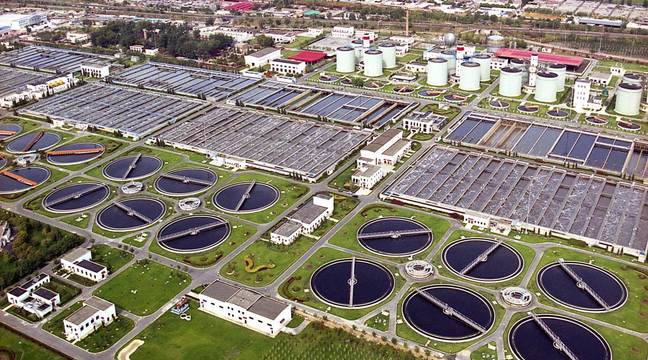
当前课程知识点:Water and Wastewater Treatment Engineering: Biochemical Technology > Chapter 1 Basic principles of wastewater biological treatment > Section 1.1 Principles of wastewater aerobic biological treatment > 1.1 Principles of wastewater aerobic biological treatment
返回《Water and Wastewater Treatment Engineering: Biochemical Technology》慕课在线视频课程列表
返回《Water and Wastewater Treatment Engineering: Biochemical Technology》慕课在线视频列表
同学们好!欢迎来到水处理工程MOOC课堂
今天,我们来学习第一章,废水生物处理的基本原理
这一章共分5个内容,分别是废水好氧生物处理的原理
废水可生化性原理及其判别、废水厌氧生物处理的原理
以及生物脱氮原理和生物除磷原理
首先我们来学习第一节,废水好氧生物处理的原理
主要内容有三个,第一是几个基本定义
第二是好氧生物处理的基本生物过程
第三是影响废水好氧生物处理的主要因素
首先我们来看三个基本定义
我们应该都听说过,好氧微生物、厌氧微生物或者兼性微生物
它们的定义呢,大家可以来看
好氧微生物是指在有氧条件下,才能进行正常的生理生化反应的微生物
绝大部分的微生物,包括绝大部分的细菌都是好氧微生物
甚至包括动物和人类,也是好氧的生物
厌氧微生物呢,是指在无分子态氧存在的条件下
才能进行正常生理生化的微生物
主要有产氢产乙酸菌、产甲烷细菌、以及硫酸盐还原菌等
兼性微生物,有时也被称为兼性厌氧菌或兼性好氧菌
它们的适应范围很广,在有氧和无氧的环境中都能生长
一般以有氧生长为主,在有氧条件下,它们通过好氧呼吸来获得能量
在无氧条件下,它们通过发酵或无氧呼吸来获得能量
兼性微生物主要有大肠杆菌、产气肠杆菌等
我们来看废水好氧生物处理的基本生物过程
一共有三个方面,分别是分解反应、合成反应和内源呼吸
分解反应是通过好氧微生物在氧气的作用下
把有机物氧化成为二氧化碳、水、氨氮等的过程,还会有大量的能量产生
合成反应,有时也称为合成代谢,或者同化作用
是指微生物利用分解反应所产生的能量,将一些反应中产物合成自身的细胞物质
这个公式中,我们给出了通常用的细菌细胞的实验分子式,C5H7NO2
但我们也知道,微生物细胞中还含有磷、硫等其他元素
所以这里还给出了其它两个细菌的实验分子式
通过合成反应合成了新的细胞物质以后
其中的一部分会通过这个所谓的内源呼吸作用,有时也称为自身氧化作用
被氧化分解成二氧化碳、水和氨氮等
上面这三个反应,组成了好氧生物处理的基本生物过程
我们可以用这个示意图再来看看刚才介绍过的三个生物过程
废水中的可生物降解的有机物,在好氧微生物的作用下
在有氧气的参与下,其中的一部分会被直接氧化分解,获得能量
另外一部分,则会被合成为新的细胞物质
而一部分新合成的细胞物质,又会继续在氧气的作用下
通过微生物的内源呼吸而被分解,最后会留下一些细胞残留物
因此在这个过程中,我们看到废水中的有机物
在微生物的作用下,会被转化成为三类主要的产物
一类产物是一些无机的代谢终产物,一类是能量
第三类则是合成的细胞物质以及细胞残留物质
最后这一部分物质,将来会作为剩余污泥,从废水处理系统中排出
我们都学过生物化学,知道分解和合成这二者是相互依赖、不可分割的
主要表现在如下2个方面:分解过程会为合成作用提供能量和前体物
而合成作用,则可以为分解过程提供物质基础,如催化反应过程中所需要的酶
同时,分解过程是产能过程,而合成过程则是耗能过程
第二,这两者对于废水中的有机物的去除,都有重要贡献
分解过程是将一部分有机物完全氧化成无机终产物
而合成作用则是将另一部分有机物转化合成为新的细胞物质
第三,合成量的大小,对于后续污泥的处理有直接的影响
因为污泥的处理费用是城市污水处理厂总费用的重要组成
不同形式的有机物被生物降解的历程也各不相同
因为一方面来看,结构简单、分子量小、而且可溶性好的物质,可以直接进入细胞壁
而结构复杂、分子量较大、胶体状或颗粒状的物质,则首先需要被微生物吸附
然后在胞外酶的作用下被水解、液化,最后才能进入细胞
另一方面,有机物的化学结构不同,其降解历程也不一样
像糖类物质、脂类物质、蛋白质等,这些物质的降解过程,都各不一样
下面我们来介绍这一节的第3个内容,好氧生物处理过程的主要影响因素
因为是好氧生物处理,第一个因素就是溶解氧
一般需要在主反应区内将溶解氧控制在1到2mg/L
第二个重要因素是水温,我们在前面已经学习过
在一定范围内,随着温度的升高,生化反应和微生物的增殖速率就会加快
一般来说,一般认为温度每升高10℃,反应速率会增加1倍
好氧生物处理的最适宜温度是在15到30℃之间
超过40℃或小于10℃,都会有很不利的影响
另外,由于微生物细胞内的一些物质,如蛋白质、核酸等对温度很敏感
温度突升或突降,都有可能对其生物活性产生不可逆的不利影响
第三个主要的影响因素,是营养物质
在前面,我们已经学习了细菌的实验分子式
因此,可以知道在细菌的细胞组成中,碳、氢、氧、氮四种元素约占90-97%
另外的3-10%是一些无机营养元素,如磷、硫以及一些金属元素等
因此我们在处理实际废水的时候,有时就需要针对性的补充一些营养元素
如果处理对象是生活污水时,一般不需要添加营养物质
但是对于一些特殊的工业废水来说,特别是一些有机工业废水
可能它们含有的氮、磷等营养元素不足,那就需要按照一定比例进行添加
对于好氧生物处理来说,一般需要按照BOD:N:P = 100:5:1来补充投加N和P
而对于厌氧生物处理来说,应该按照COD:N:P = 400:5:1来补充投加N和P
有时还需要适当补充其它无机营养元素
像K、Mg、Ca、S、Na以及一些微量金属元素像Fe、Co、Ni、Mo
这里提到的微量金属元素,对于后续要讲到的厌氧生物处理,是非常重要的
第四个因素,是pH值,一般来说,好氧生物处理的pH值要求在6.5-8.5之间
如果pH值小于4.5,就可能导致活性污泥中的真菌占优势,会导致污泥膨胀
但是,另一方面,微生物的活动有时也会反过来影响混合液的pH值
像我们在后面会讲到的氨氮的硝化过程就会导致pH值下降
而厌氧中的产甲烷过程会导致pH值的上升
第五个因素,是有毒物质或者说是抑制性物质
主要有重金属、氰化物、H2S或硫化物,还有卤族元素及其化合物
还有就是有毒有害的一些大分子有机物,像酚、醇、醛等
第六个因素,是有机负荷率
首先,我们来看看有机负荷率的概念
它是指单位质量的微生物在单位时间内所承受的有机物的量
一般用kgBOD5/(kgVSS·d),或者是kgCOD/(kgVSS·d)来表达
当有机物负荷率超过微生物所能承受的范围时,就会不利于微生物的生长和活性的发挥
也会不利于有机污染物的降解
第七个因素是氧化还原电位
一般来说,对于好氧细菌,它要求在+300~400Mv之间
至少要求大于+100mV
对于厌氧细菌,一般要求至少小于+100mV
对于严格厌氧细菌来说,就要求小于-100mV,甚至要求小于负的-300mV
好,今天这一节的内容,我们就讲到这里,谢谢
-Section 0.1 Development Status of Wastewater Treatment Process
--Section 0.1 Development Status of Wastewater Treatment Process
-Section 0.2 Typical Processes of Wastewater Biological Treatment
--Section 0.2 Typical Processes of Wastewater Biological Treatment
-Section 1.1 Principles of wastewater aerobic biological treatment
--1.1 Principles of wastewater aerobic biological treatment
-Section 1.2 Principles and determination of wastewater biodegradability
--1.2 Principles and determination of wastewater biodegradability
-Section 1.3 Principles of wastewater anaerobic biological treatment
--Section 1.3.1 Principles of wastewater anaerobic biological treatment(1)
--Section 1.3.2 Principles of wastewater anaerobic biological treatment(2)
-Section 1.4 Principles of wastewater biological nitrogen removal
--Section 1.4 Principles of wastewater biological nitrogen removal
-Section 1.5 Principles of wastewater biological phosphorus removal
--Section 1.5 Principles of wastewater biological phosphorus removal
-Chapter 1 Homework
-Section 2.1 Basic concept of activated sludge process
--Section 2.1.1 Basic concept of activated sludge process
--Section 2.1.2 Basic concept of activated sludge process
-Section 2.2 Growth rule of activated sludge and its application
--Section 2.2 Growth rule of activated sludge and its application
-Section 2.3 Running mode of activated sludge process
--Section 2.3.1 Running mode of activated sludge process(1)
--Section 2.3.2 Running mode of activated sludge process(2)
-Section 2.4 Kinetics of active sludge process
--Section 2.4.1 Kinetics of active sludge process(1)
--Section 2.4.2 Kinetics of active sludge process(2)
--Section 2.4.3 Kinetics of active sludge process(3)
--Research and Development of Kinetic Model of Activated Sludge Process
-Section 2.5 Principle, calculation and equipment of aeration
--Section 2.5.1 Principle, calculation and equipment of aeration(1)
--Section 2.5.2 Principle, calculation and equipment of aeration(2)
-Section 2.6 Designing of activated sludge process
--Section 2.6 Designing of activated sludge process
-Section 2.7 Operation and management of active sludge process
--Section 2.7.1 Operation and management of active sludge process (1)
--Section 2.7.2 Operation and management of active sludge process (2)
-Chapter 2 Homework
-Section 3.1 Basic principle of biofilm
--Section 3.1 Basic principle of biofilm
-Section 3.2 Biofilter process
--Section 3.2.1 Biofilter Process (1)
--Section 3.2.2 Biofilter process (2)
--Section 3.2.3 Biofilter process (3)
-Section 3.3 Biodisk process
-Section 3.4 Biological contact oxidation process
--Section 3.4 Biological contact oxidation process
-Section 3.5 Aerobic biological fluidized bed process
--Section 3.5 Aerobic biological fluidized bed process
-Chapter 3 Homework
-Section 4.1 Oxidation ditch process
--Section 4.1 Oxidation ditch process
-Section 4.2 A-B process
-Section 4.3 SBR process
-Section 4.4 MBR process
-Chapter 4 Homework
-Section 5.1 Overview and characteristics of development of anaerobic biological treatment
--Section 5.1 Overview and characteristics of development of anaerobic biological treatment
-Section 5.2 Anaerobic digester
--Section 5.2 Anaerobic digester
-Section 5.3 Anaerobic contact process and anaerobic filter process
--Section 5.3 Anaerobic contact process and anaerobic filter process
-Section 5.4 UASB process
-Section 5.5 Other anaerobic biological treatment process
--Section 5.5 Other anaerobic biological treatment process
-Section 5.6 Operation management of anaerobic biological treatment process
--Section 5.6 Operation management of anaerobic biological treatment process
-Chapter 5 Homework
-Section 6.1 Introduction
-Section 6.2 Biological nitrogen removal process and technology
--Section 6.2 Biological nitrogen removal process and technology
-Section 6.3 Biological phosphorus removal process and technology
--Section 6.3 Biological phosphorus removal process and technology
-Section 6.4 Simultaneous nitrogen and phosphorus removal process
--Section 6.4 Simultaneous nitrogen and phosphorus removal process
-Chapter 6 Homework
-Section 7 Natural biological treatment process
--Section 7 Natural biological treatment process
-Chapter 7 Homework
-Section 8.1 Source, nature and treatment of sludge
--Section 8.1 Source, nature and treatment of sludge
-Section 8.2 Sludge thickening and digestive stability
--Section 8.2 Sludge thickening and digestive stability
-Section 8.3 Sludge conditioning, dehydration and incineration
--Section 8.3 Sludge conditioning, dehydration and incineration
-Chapter 8 Homework
-Section 9 Wastewater Discharge and Reuse
--Section 9 Wastewater Discharge and Reuse
-Chapter 9 Homework


